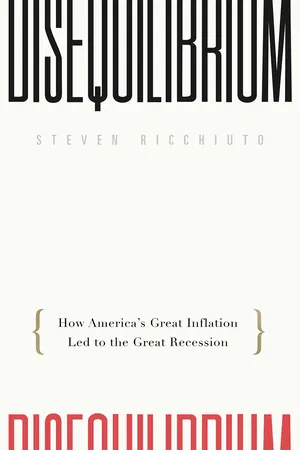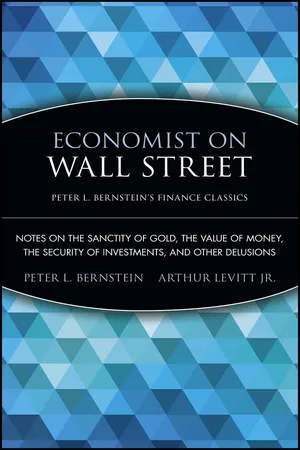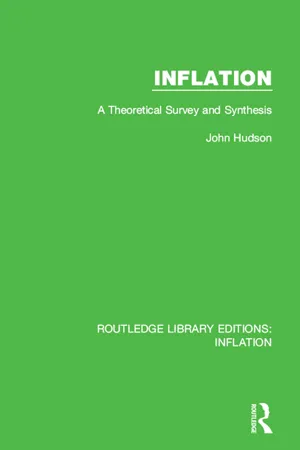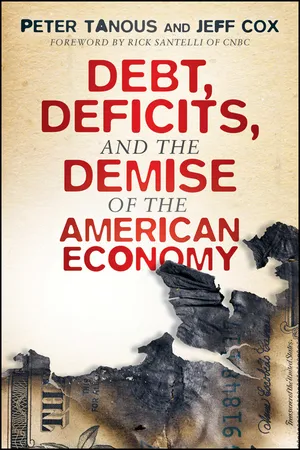Economics
The Great Inflation
The Great Inflation refers to a period of exceptionally high inflation rates experienced in the United States during the 1970s. It was characterized by rapidly rising prices, reaching double-digit levels, and was fueled by a combination of factors including increased government spending, oil price shocks, and wage-price spirals. The Great Inflation had significant economic and social impacts, leading to policy changes and a shift in central bank priorities.
Written by Perlego with AI-assistance
Related key terms
4 Key excerpts on "The Great Inflation"
- eBook - ePub
Disequilibrium
How America's Great Inflation Led to the Great Recession
- Steven Ricchiuto(Author)
- 2016(Publication Date)
- Greenleaf Book Group Press(Publisher)
Section 4 The Great InflationCauses
Economists refer to the period from 1965 to 1980 as The Great Inflation. During this 15-year period, headline inflation—the All Items Consumer Price Index—rose to 10.5% in March 1980 from just 1.1% in January 1965. Economists have been fascinated by this period almost to the same extent as they are drawn to the period of the Great Depression. Many of the analyses of this period tend to center on the causes of this abrupt acceleration in prices and on the negative macroeconomic consequences brought about by rapidly rising prices. Central bankers’ contributions to both the acceleration in inflation and its more recent downturn dominate another area of research.Our interest in The Great Inflation is directed more toward the events it triggered and how they helped shape the world of excess supply we live in today. In particular, the institutionalization and globalization of wealth and the belief that double-digit returns are the norm—not the exception—are critical developments of policies implemented to reverse the acceleration in inflation during this period. The interaction between these three developments set the stage for the transition from excess demand to excess supply. This fundamental shift has dominated economic developments and the business cycle since the late 1980s. However, members of the economic community continue to view the world as dominated by excess demand, ignoring the critical transition that is at the heart of today’s macroeconomic problem—global deflation rates.The policy response to The Great Inflation triggered the fundamental changes in the economy that explain why inflation cycles have given way to credit cycles in the wake of the move from excess demand to excess supply. As such, an understanding of how policymakers initially misread the early signs of building inflation pressures in the late 1950s and early 1960s can also provide insight into why deflationary pressures have been largely ignored since the 1990s. For over 25 years, the changed nature of the business cycle has been largely overlooked, even though the last three business cycles have been associated with major credit events—not with demand-led inflation. - eBook - ePub
Economist on Wall Street (Peter L. Bernstein's Finance Classics)
Notes on the Sanctity of Gold, the Value of Money, the Security of Investments, and Other Delusions
- Peter L. Bernstein(Author)
- 2008(Publication Date)
- Wiley(Publisher)
The third and most disturbing count against the classic medicine, in addition to its failure to curtail price increases in the service areas and its inflationary and irrational impact on resource allocation, is the giant risks it takes in dealing with the inflationary mentality. For inflation is more than an excess of demand over supply; it is also a state of mind. Americans have learned this the hard way in the present inflationary episode because it is unique in our recent history. After World War II, although prices rose very sharply from 1946 to 1948, rapid conversion to peacetime production and the absorption of millions of ex-GIs into the labor force enabled supply to grow at an extraordinary rate and to overwhelm demand within three years. The pattern repeated itself after Korea. In 1957-1958, before the inflationary virus could really get into our veins, the classic medicine contributed to the deepest of our postwar recessions and then kept us below maximum growth rates for at least three years.This time, the story has been different. First, prices had been remarkably stable all during the period of impressive economic growth that preceded the 1965 escalation in Vietnam, so that inflationary expectations were slow to get started even though prices soon started climbing at a disturbing rate. But President Johnson, for a variety of reasons, postponed too long the unattractive recommendation of a tax increase.The Federal Reserve jammed on the monetary brakes in 1966. Then, although the brakes really took hold and prices did flatten out (again, except in the service area), fear of overkill soon led to a relaxation of monetary policy. Easier money also accompanied the early months after passage of the tax increase in mid-1968.These vacillations of policy, combined with a genuine condition of demand in excess of supply, finally convinced the American people that nothing would stop inflation and that now it was every man for himself. With the prices of everything climbing so fast, no union leader could afford to ask for a smaller wage increase than his competitors were winning. No businessman could wait too long to raise prices, for fear that he would never be able to keep pace with his costs and maintain his profit margin. The most serious and distressing aberration of the inflationary mentality also appeared in earnest: buy today because tomorrow it will cost more.This attitude has taken hold to some extent with consumers, but it has become endemic in the business community where, despite much excess capacity, high financing costs, and flat sales curves, spending for the expansion of plant and equipment has continued to climb. When the inflationary wave finally subsides, an incalculable amount of this expenditure will turn out to have been ill-timed and misplaced. - eBook - ePub
Inflation
A Theoretical Survey and Synthesis
- John Hudson(Author)
- 2016(Publication Date)
- Routledge(Publisher)
The increase in unemployment occurred because with the increase in prices, real disposable income fell sharply. This led to a reduction in consumers’ expenditure which affected business confidence and thus investment. All this, added to similar experiences in other countries which thus hit exports, spelt the beginning of a major recession. The steep decline in economic activity reached a climax in the first quarter of 1975. The administration responded with tax cuts and output recovered quickly with real GNP rising at an annual rate of 8.5 per cent in the second half of that year. However, excess capacity remained large and as can be seen unemployment began falling only very slowly, and by 1979 was still 5.8 per cent. The rate of price inflation also subsided slightly after the initial impact of the oil price rise had been absorbed. Wage inflation on the other hand continued to increase, and at 8.6 per cent in 1978 was higher than at any other time in the previous thirty years.Finally in 1979–80 we come to the last dramatic surge in price inflation. In 1979 prices rose by 11.5 per cent. In 1980 they appear to be accelerating still further, with the consumer price index being 13.5 per cent above the average level in the previous year. The reason for this latest surge is not hard to find. Once more the rising cost of energy seems to be the reason, with the relevant component of the CPI almost doubling since 1978, following further OPEC price rises. Also important has been the increased cost of home ownership, which has risen by almost 40 per cent in the last two years, largely as a result of high interest rates. As in 1974 this sudden increase in the price level is having a significant effect on unemployment, with much the same mechanism at work as then.There are several points to note from this discussion. First, as in the UK, it does seem that in general wage inflation leads price inflation, and also coincides more closely with the unemployment series than does price inflation. Thus in the period 1950–70 there were five discernible peaks in the unemployment series, all of which corresponded with troughs in the wage inflation series, but only three with the price inflation series. In the same period there were just three clear troughs in the unemployment series, each of which coincided with a peak in the wage inflation series, but none of which did so in the price inflation series. Furthermore in two of the years when wage inflation peaked prices did so in the following year. Conversely there seems to be no case in this earlier period when prices led wages. Thus, again as with the UK, it seems probable that the inflationary mechanism in this earlier period was one where excess demand first affected wages, and these in the form of increased costs then led to an increase in prices. - Peter J. Tanous, Jeff Cox(Authors)
- 2011(Publication Date)
- Wiley(Publisher)
The lesson of Diocletian holds significance today in part because it provides a philosophical warning on overreaching government programs while vividly displaying the practical dangers of trying to devalue your way out of a crisis. Diocletian wasn’t stupid, nor are today’s policy makers who think there won’t be a price to pay when the bill comes due for all those dollars out there in circulation. President Barack Obama and Federal Reserve Chairman Ben Bernanke are both smart men who believe extreme circumstances necessitated extreme measures. Timothy Geithner and his predecessor, Henry Paulson, both recognized the dangers of devaluation, but made reasoned and considered decisions to take that risk. Even as this book was being written, there was nary an economist to be found talking about inflation. “Deflation is the primary risk” is their mantra, the emerging specter of Nassim Taleb’s Black Swan be damned.Inflation: Is It Bigger Than a Breadbox?This is a good time, then, to consider just what inflation is. If you ask your neighbor to define inflation, he’ll probably talk to you about soaring prices for gasoline, beer, and groceries. And while these are all perfectly valid descriptions of the effects of inflation, they don’t really address the causes . It is well to remember that this is not a case of the chicken or the egg. The causal relation is clear. Inflation happens when too much money chases too few goods, and the result is a rise, sometimes dramatic, in the prices of goods we have to purchase in order to conduct our daily lives.We like to present a definition of inflation from the brilliant economist and philosopher David Hume, who found it “self-evident” that prices and inflation depended entirely on the supply of goods compared to the supply of money. Hume said an increase in the amount of goods means “they become cheaper,” while an increase in money supply means goods “rise in their value.”Hume (1711–1776) saw the danger that excessive money in the economic system posed and studied closely its effects. So if we are to continue our linear thinking through the discipline of epistemology, Hume’s simple observations that the supply of money and the phenomenon of inflation are inextricably linked are essential to the conclusions of this book. Pump so much money into the economy that it outstrips an optimal level of goods, and you get inflation. Simple as that. The cumulative impacts of all the inflationary pressures at hand will be discussed in greater detail in the ensuing chapter, but it is important to keep Hume’s gentle analysis in mind as we take a further trip through the annals of inflation history.
Learn about this page
Index pages curate the most relevant extracts from our library of academic textbooks. They’ve been created using an in-house natural language model (NLM), each adding context and meaning to key research topics.



